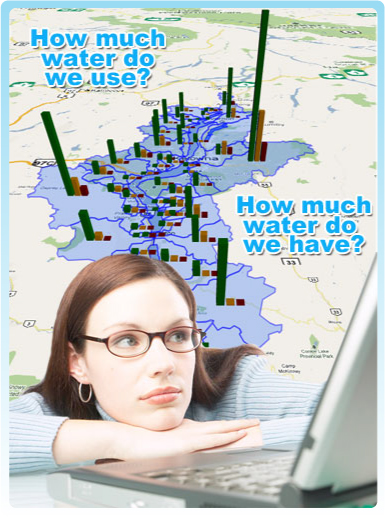Overall, the results of the scenarios do not point to a sudden, dramatic decline in water availability.
Risks of water shortages for human use and environmental needs are increasing, but it is possible to compensate through land-use planning, careful water management, and by reducing demand.
These models are an extremely valuable tool for adaptation, and provide answers to specific questions about current and future water needs in different parts of the basin, and the interdependence of water sources.
Specific Phase 2 Implications:
Demand
- Climate change, population growth, and expansion of the agricultural land base are expected to result in significantly increased water withdrawals from surface and groundwater sources in the Okanagan Basin, especially during summer months.
- Competition for water in the basin, particularly during the summer (e.g. when there are flow reductions in fish-bearing streams) will likely intensify in future.
- There is significant potential for conservation and demand-management to mitigate these effects, but demand management alone may not be a sufficient response to future changes.
- Augmenting water supply by increasing water storage capacity would help meet future water management challenges, although increasing storage is more costly than reducing demand.
- Key water sources include upland storage reservoirs, groundwater, and main valley lakes.
- Storage reservoirs require adequate protection for long-term water security.
- Improved knowledge is necessary:
- Sustainable limits of groundwater
- Evaporation loss from the main valley lakes
- It will likely become more challenging to provide and maintain environmental flows, especially in late summer and early fall. Additional storage may be needed for this purpose.
Supply
- Management of upland storage reservoirs will become more challenging as snowpacks decline, more winter precipitation occurs as rain, and snowmelt occurs earlier in the spring. These trends reduce the amount of water stored as snow for ongoing refill of reservoirs and aquifers in early summer.
- With three consecutive years of drought, it will become more difficult to maintain current Okanagan Lake levels and adequate stream-flows in the Okanagan River downstream of Penticton.
- Groundwater is increasingly used as a water source as surface water becomes fully allocated on some sources. Without regulation, groundwater use is likely to expand, which will lead to management challenges because surface and groundwater systems are interconnected.
- Current water licence volumes may not be sufficient to satisfy demands on some streams in future, particularly on those with limited or no storage.
- The models are based on available scientific and water management information; however, the quality of that information is variable, and in some areas, particularly with respect to stream-flow, groundwater, actual water use, lake evaporation and evapotranspiration, better information will improve the models.
- Most at risk for water shortages are water suppliers relying on upland storage reservoirs. The full volume of water licences will not necessarily always be available – even for those drawing from main stem lakes – depending on weather conditions. Risk for all water suppliers would be reduced if reservoir storage is protected and expanded.
Project Downloads:
See webpages under “Key Findings”
- Summary Report – Key Findings and Recommendations (55Kb PDF)

